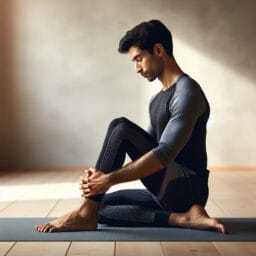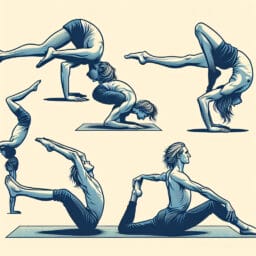
Master the Lotus Pose: A Comprehensive Guide to Perfecting this Yoga Essential
Table of Contents
- Introduction: Brief overview of the Lotus Pose and its benefits
- The History of the Lotus Pose
- The Benefits of the Lotus Pose
- Preparatory Poses
- Step-by-Step Guide to the Lotus Pose
- Common Mistakes and How to Avoid Them
- Advanced Variations of the Lotus Pose
- Conclusion: Recap of the importance and benefits of the Lotus Pose
- Frequently Asked Questions
Introduction: Brief overview of the Lotus Pose and its benefits
The Lotus Pose, or Padmasana, is a quintessential element in yoga and meditation practices, offering profound physical and mental benefits. This advanced pose, requiring flexibility of the hip sockets and knee joints, fosters stability in the lower body while gently stretching the upper body. Perfecting this position involves a detailed process – initiating with legs extended on a folded blanket for support, progressing to the left leg folding into half lotus or full lotus as your practice deepens. As you ease into this posture over time, chronic injury concerns like knee pain dissipate as strength builds. Delving deeper than its physical prowess, Lotus Pose is also an incredible tool for fostering mental clarity. The subtle act of resting your arms and focusing on breathwork offer undeniable tranquility during long periods of meditation. In essence, whether it’s creating flexibility in your hip crease or inviting stillness to your mind—the Lotus Pose truly encapsulates a holistic approach to well-being.
The History of the Lotus Pose
The Lotus Pose, or Padmasana, traces its roots back to ancient Indian yogic traditions and religions where it was often used during long periods of meditation. Its significance transcends cultural boundaries, symbolizing purity and spiritual awakening in Buddhism while representing divine beauty and grace in Hinduism. Over the years, variations such as the half lotus pose have emerged providing a gentler option for beginners or those with less flexibility in their hip sockets and knee joints. Practicing on a folded blanket can further aid alignment, facilitating both stability of the lower body and a deep stretch for the upper body. The full lotus pose presents a greater challenge; however, mastering this advanced pose can significantly elevate one’s yoga practice both physically by improving posture and hip flexibility, but also mentally by enhancing focus during meditation sessions. Whether you’re an aspiring yogi or seasoned practitioner exploring new poses for your library – from simple hip openers to complex asanas – understanding these nuances can deepen your practice considerably.
The Benefits of the Lotus Pose
The Lotus Pose, a classic in the pose library of yoga, is more than just an advanced pose; it’s an investment in holistic health. Physically, your body experiences a remarkable transformation. The lower body stabilizes as you tuck the left leg into half or full lotus position steps while the upper body receives a deep stretch—an ideal solution for knee joint discomfort or chronic injury. Your hip sockets gradually adapt to this internal rotation and over time, enhance your flexibility remarkably. On the mental front, Lotus Pose Padmasana is synonymous with tranquility and focus. With arms resting on your knees for long periods during meditation, it becomes a meditative posture that invites calmness into your mind—perfect to balance life’s hectic pace. Whether it’s the beginners’ easy pose Sukhasana or the advanced full lotus position, mastering these poses can be transformative for both physical endurance and mental resilience.
| Title | The Benefits of the Lotus Pose |
|---|---|
| Content | The Lotus Pose, a classic in the pose library of yoga, is more than just an advanced pose; it’s an investment in holistic health. Physically, your body experiences a remarkable transformation. The lower body stabilizes as you tuck the left leg into half or full lotus position steps while the upper body receives a deep stretch—an ideal solution for knee joint discomfort or chronic injury. Your hip sockets gradually adapt to this internal rotation and over time, enhance your flexibility remarkably. On the mental front, Lotus Pose Padmasana is synonymous with tranquility and focus. With arms resting on your knees for long periods during meditation, it becomes a meditative posture that invites calmness into your mind—perfect to balance life’s hectic pace. Whether it’s the beginners’ easy pose Sukhasana or the advanced full lotus position, mastering these poses can be transformative for both physical endurance and mental resilience. |
| Image |  |
Preparatory Poses
The Lotus Pose, when done correctly, is a powerful tool that can transform your yoga practice. Integrating this advanced pose into your routine not only improves the flexibility of your hip sockets and knee joints but also strengthens the lower body. The position of your left leg in half or full lotus, depending on your comfort level, provides stability while creating flexibility in the hip crease. With legs extended on a folded blanket for support, it further helps align the spine to reduce knee pain from chronic injury. As an essential part of your pose library poses — whether you’re working through type yoga poses or focusing on benefit yoga poses — mastering the Lotus Pose is an invaluable skill that complements other forms like easy pose sukhasana.
But how do you prepare for this intricate asana? Starting with hip-opening poses can help condition your body for the internal rotation required in Lotus Pose Padmasana. Poses like Butterfly Pose (Baddha Konasana) and Pigeon Pose (Eka Pada Rajakapotasana) are excellent hip openers that loosen up tight muscles around hips lift area which paves way for easier transition into full lotus pose.
Remember to listen to your body during these preparatory exercises; pushing too hard too fast could lead to injury. Approach each movement mindfully and respect where you are at in your practice today— knowing when to retreat is just as important as knowing how much further you can stretch.
And finally, meditation boosts the overall benefits of practicing Lotus pose by promoting mental clarity and focus. Whether it’s guided meditation or silent reflection during long periods, incorporating meditation into daily practice encourages mindfulness which helps deepen all aspects of Yoga teaching including philosophy sanskrit history-related discourses.
In essence, whether you’re a beginner venturing beyond basic style benefit yoga or an experienced practitioner looking for greater challenge in their anatomy yoga sequences – understanding these nuances about Benefits and variations of Lotus Pose.can deepen your practice considerably.
| Preparatory Poses for Lotus Pose | Description |
|---|---|
| Lotus Pose (Padmasana) | An advanced yoga pose that improves flexibility and strength in the lower body. It helps in reducing knee pain from chronic injury and aligns the spine. |
| Butterfly Pose (Baddha Konasana) | A hip-opening pose that conditions the body for the internal rotation required in the Lotus Pose. It helps to loosen up tight muscles around the hip area. |
| Pigeon Pose (Eka Pada Rajakapotasana) | Another hip-opening pose that prepares the body for a transition into the full Lotus Pose. It also helps to loosen up tight muscles around the hip area. |
| Meditation | Boosts the overall benefits of practicing the Lotus Pose by promoting mental clarity and focus. Encourages mindfulness which deepens all aspects of Yoga teaching. |
Step-by-Step Guide to the Lotus Pose
Mastering the Lotus Pose, or Padmasana, is a journey that requires patience and dedication. It begins with the easy pose Sukhasana— legs extended on a folded blanket for comfort — before progressing to the half lotus position where you gently place your left ankle on your right thigh. This initial step helps create flexibility in your hip crease and strengthens the lower body. As you advance, draw your outer ankles closer to align with your hips lift – this internal rotation of the hip sockets is crucial to achieving full lotus pose. However, be mindful of any discomfort in knee joints or chronic injury; remember, pushing beyond limits can do more harm than good.
Proper alignment also plays an integral role in mastering this advanced pose correctly—your spine should be sitting upright and arms resting on knees close during long periods of meditation—a meditative posture that fosters tranquility of mind.
Finally, don’t forget to incorporate type yoga poses from our pose library into your practice yoga sequences for holistic improvement. From anatomy yoga sequences focusing on muscle engagement and mobility to style benefit yoga emphasizing fluidity and grace—you have an array of choices at hand!
As with all yoga teachings and practices— whether it’s exploring philosophy Sanskrit history or studying foundations chakras—the ultimate goal is self-improvement both physically and mentally. So embrace every bit of progress you make along this journey—the first time you can slowly lift yourself into full lotus position without pain—or when meditate science finally clicks during guided meditation—all these milestones are a testament to your commitment towards nurturing body-mind harmony.
Common Mistakes and How to Avoid Them
As you venture onto the path of mastering the Lotus Pose, there are several common errors that can impede your progress. Mistakenly forcing your body into full lotus pose too soon, for instance, can cause strain on the knee joints and hip sockets. Instead, beginners should gradually ease into this advanced pose starting with an easy pose Sukhasana or half lotus position. Here, legs are extended outwards as one sits on a folded blanket to provide cushioning support to the lower body while enhancing flexibility in the hip crease. Proper alignment is essential at every stage – from how you position your feet and ankles to how your arms rest during long periods of meditation. It’s crucial not to overlook these fundamentals as they build towards achieving that perfect meditative posture where upper body experiences a deep stretch while mind achieves tranquility through focused breathing exercises. Such mindfulness helps avoid chronic injury concerns such as knee pain and also fosters harmony between mind and body – a key aspect of yoga teachings including anatomy yoga sequences or philosophy sanskrit history discourses which go beyond mere physical postures.
Advanced Variations of the Lotus Pose
Delving deeper into the layers of Lotus Pose reveals its astonishing versatility, offering a range of variations to keep your yoga practice dynamic and challenging. For those who have comfortably mastered the standard version with legs extended on a folded blanket, consider graduating to half or full lotus position steps that call for greater flexibility and internal rotation in the hip sockets. These advanced variations not only provide a deep stretch for your upper body but also strengthen the lower body significantly—all while maintaining perfect alignment of spine sitting upright. Adapting to such complex asanas takes time; however, embracing this journey brings holistic benefits as it fosters extraordinary resilience both physically and mentally—an element at the heart of authentic yoga teachings including style benefit yoga, anatomy yoga sequences, and philosophy sanskrit history discussions. But caution is advised lest you push too hard causing undue strain on your knee joint or exacerbating any chronic injury—creating flexibility without compromising safety should be paramount. Finally, remember that each variation of Lotus Pose—from easy pose Sukhasana to full lotus pose—is essentially an invitation to explore a deeper level of self-awareness through focused meditation practices—an integral part of the yoga lifestyle aiming towards balance in all areas from food nutrition recipes people travel retreats astrology video essentials to on-demand classes how-to conversations life culture gear apparel beauty themes.

Conclusion: Recap of the importance and benefits of the Lotus Pose
The journey to mastering the Lotus Pose is a testament to resilience, patience, and mindfulness. Not just a physical feat—the transformation of your body as it adapts to the intricate pose from extended legs on a folded blanket to full lotus position steps—it’s also an exploration of mental fortitude. With each practice yoga session, you’re adding another layer of depth to your yoga teaching tools. You’re not just improving hip flexibility or alleviating chronic knee pain—there’s a holistic elevation happening here. As you sit with arms resting and focus on your breathwork during long periods, there’s tranquility seeping into your mind—a meditative posture that complements any meditation guided routine. And such peace and clarity are invaluable—in our world often dominated by hustle and noise. Whether you’re still at beginners’ easy pose Sukhasana or advancing towards full lotus pose—embrace this journey—because every step is bringing you closer not just to achieving an advanced pose, but also finding that balance in life we all seek—a harmony between body-mind-spirit—an essence at the heart of philosophy Sanskrit history discourses in yoga teachings. So keep practicing, keep exploring—you’re nurturing holistic well-being with every stretch.
Frequently Asked Questions
Q: What is the Lotus Pose and why is it important in yoga and meditation?
A: The Lotus Pose is a crucial part of yoga and meditation. It encourages physical flexibility, strength, and balance, all while promoting mental benefits like stress reduction and improved focus.
Q: Where did the Lotus Pose originate?
A: The Lotus Pose has a rich history and traditional use in yoga. It originated in ancient India and has evolved over time, gaining significance in different cultures for its physical and mental health benefits.
Q: What are the benefits of practicing the Lotus Pose?
A: The Lotus Pose provides both physical and mental benefits. Physically, it helps improve flexibility, strength, and balance. Mentally, it aids in stress reduction and promotes a deepened focus.
Q: How can I prepare for the Lotus Pose?
A: There are specific preparatory poses that can help condition your body for the Lotus Pose. For beginners, certain tips and methods are recommended to effectively practice these preparatory poses safely.
Q: Can you provide a step-by-step guide on how to perform the Lotus Pose?
A: Detailed instructions specific to the Lotus Pose can guide individuals on its correct execution. There are certain tips newcomers can follow and common mistakes to be aware of when beginning to learn this pose.
Q: What common mistakes do people make while performing the Lotus Pose?
A: There are common errors that can occur when performing the Lotus Pose. However, certain tips and techniques can be learned to recognize and correct these mistakes.
Q: Are there advanced variations of the Lotus Pose?
A: Yes, there are more challenging variations of the Lotus Pose for those who have mastered the basic pose. Each variation has its own set of benefits and challenges that broaden and deepen the practice.
Q: How can I continue to benefit from the Lotus Pose?
A: The key to gaining continuous benefits from the Lotus Pose is routinely practicing and learning more about this foundational yoga pose. Exploring the pose, understanding its history, learning techniques, and correcting errors will all contribute to a successful practice.



